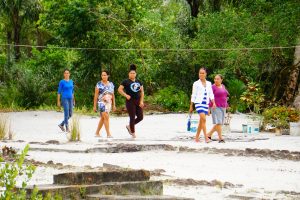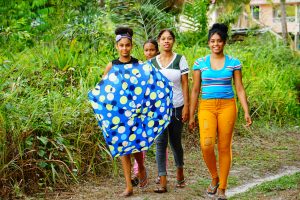By Michel Outridge
KUMAKA Village is a scenic riverine community, which is nestled in thick bamboo and other vegetation, with welcoming, but cautious residents, living in rustic settings.
Located on the mainland of Region Three (Essequibo Islands- West Demerara), Kumaka is extremely large in size and includes several villages which stretches from Arawari to Kabawari boundaries.
The mainland of the overall settlement consists of the villages of Caria Caria, Kumaka, Schonoven, King William, Akaroo and Brandsburg.
Within these villages, there is a connecting trail, demarcated only by wooden bridges. Additionally the area has five major creeks, which are pivotal to the everyday activities of the communities.
To get to Kumaka from Georgetown, one must first cross over the Demerara Harbour Bridge and head towards Parika, East Bank Essequibo, then go to Hubu Koker to board a speedboat, which then takes about 45 minutes, depending on the tide and horsepower of the vessel.
Upon reaching your destination, there is a small wooden landing, but when the tide is low, visitors have to exit in the shallow water and make their way to land.
The hectic ride is immediately forgotten once you enter Kumaka. The natural flora and fauna of the area are complemented by both sandy and muddy hills, which adds to its aura.
Kumaka Village has a population of about 50 families most of whom are related and descendants of the Dutch plantations owners.
The people are of mixed races—but overall most of them are fair-skinned in complexion.
As in many rural communities, the residents are loggers, farmers, fishermen, shop owners and miners while, they have a handful of health workers and teachers.
Although this village is on the mainland, there is no electricity, internet service or potable water supply.
The people depend on rainfall and the water sourced from the Essequibo River for household purposes. Many also have small solar panels and generators for their electricity needs.
Both cellphone signals (GT&T and Digicel) are very poor in this village since there is no tower. To make a call, residents would sometimes have to position themselves at a certain angle at different points in the community.
The nearby village of Caria Caria is central. All the social events take place at it Community Centre ground, which is perched on a steep hill.
There, also sits the multi-grade nursery and primary schools with a wooden building, which houses the community centre.
Nearby is the health outpost.
From Kumaka to Caria Caria it takes about an hour and a half by foot via the trail and about 20 minutes by speedboat.
THE VILLAGE CHAIRMAN
Meanwhile, the Pepperpot Magazine met Everton Gibson, who is the Chairman of the Community Development Council (CDC).
Gibson, who was born and bred in Kumaka, said that the Dutch who had settled there and controlled the plantations, named the community. Their descendants, which include the Woolfords, the De Camps, the Belgraves, the Collinettes, the Hohenkirks and the Gibsons among others, still reside there.
The village has a small church and plenty land which is utilised for farming.
Gibson stated that most of the young men would have to leave the village in search of work; and many would venture into the interior to do mining.
He disclosed that there is a well which was supposed to have been outfitted with a generator at Caria Caria, but it never materialised. That would have supplied water to the school, health outpost and the community centre building.
Gibson added that a lot could be done to ease the everyday burden on the community. He noted that transportation alone is rather expensive, but a necessary expense due to the landscape of the area.
“There is a need for a road linking the villages which is [currently] a trail; and the wooden bridges are damaged and needs to be repaired, a well station for potable water, electricity and an ICT hub for the schoolchildren because these things are basic necessities to enhance the lives of the people here,” he said.
The CDC Chairman added that logging was vibrant in the village, but now it is only the people with concessions who benefit, since the average man cannot afford the heavy machinery.
“Life here isn’t easy or hard, it is how you make it and what you put in, you will obviously get out of it. We have the land to farm, the river to fish and although we have no land titles we make do with this,” he said.
Gibson added that the people need assistance from the administration to boost their farming capabilities and to clean the drains in the community to alleviate flooding which often damages their crops.
“We have a village boat to take children to school, but the engine is of no use and we need that replaced to transport the elderly to seek medical attention and to get their pensions at Parika.”
He disclosed that there are no burning social issues and the people, since they are related, get along very well.



.jpg)



















